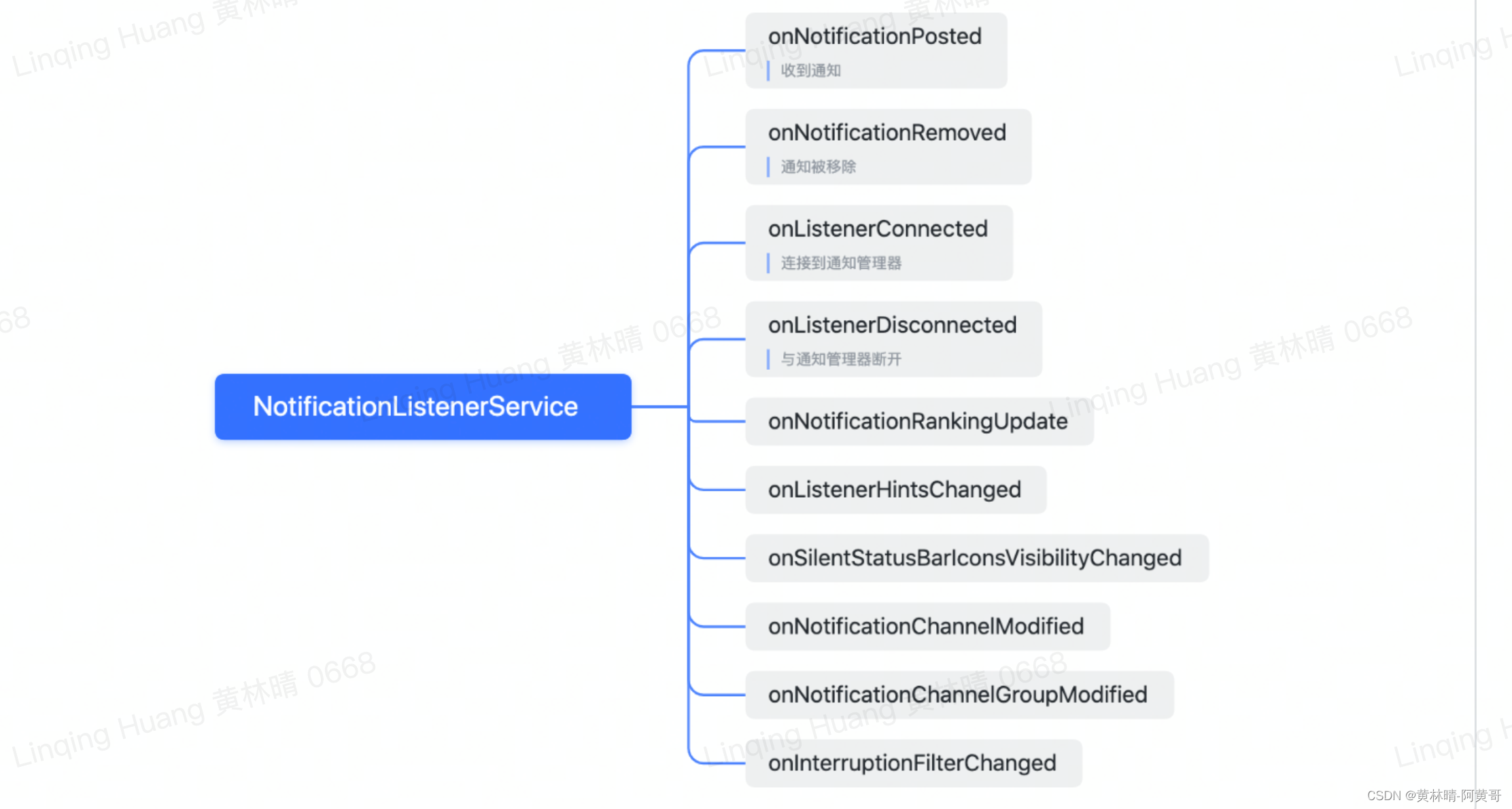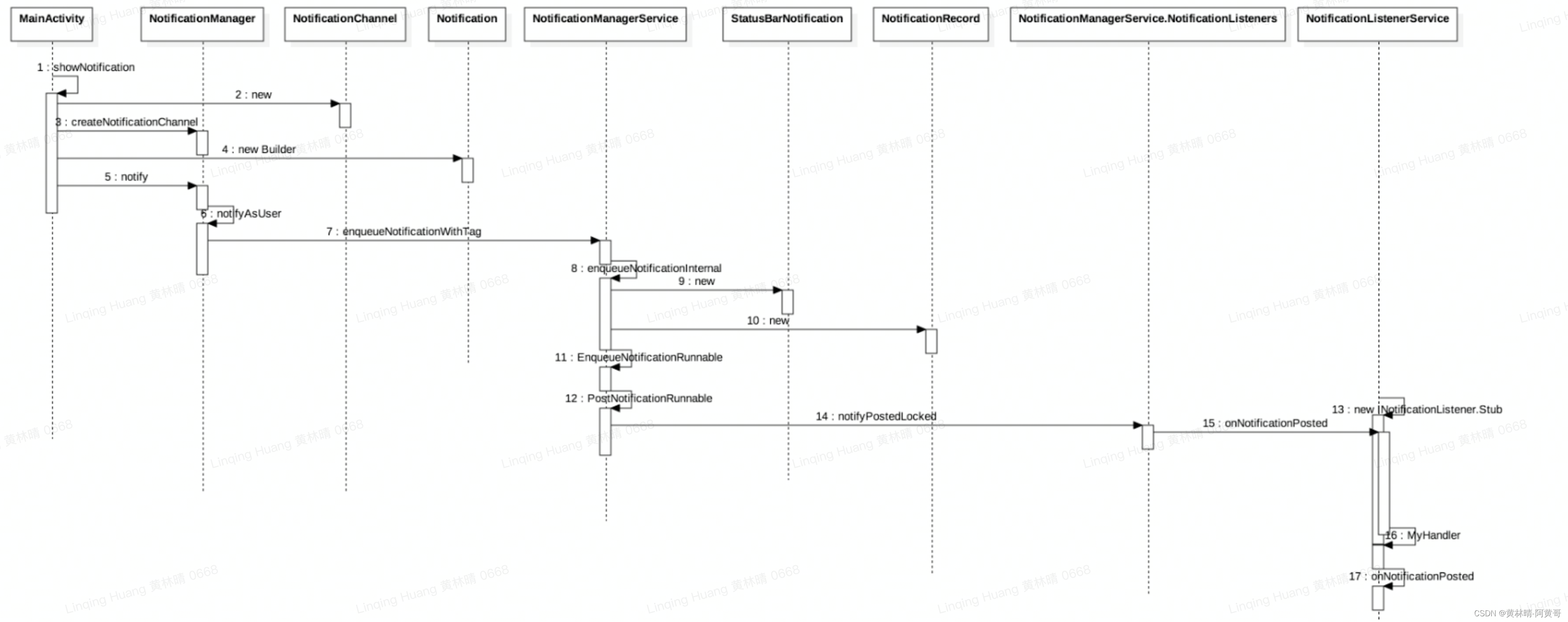深入理解通知服务NotificationListenerService原理
前言
在上一篇通知服务NotificationListenerService使用方法 中,我们已经介绍了如何使用NotificationListenerService来监听消息通知,在最后我们还模拟了如何实现微信自动抢红包功能。
那么NotificationListenerService是如何实现系统通知监听的呢?(本篇源码分析基于API 32)
NotificationListenerService方法集
NotificationLisenerService是Service的子类
public abstract class NotificationListenerService extends Service除了Service的方法属性外,NotificationListenerService还为我们提供了收到通知、通知被移除、连接到通知管理器等方法,如下图所示。

一般业务中我们只关注有标签的那四个方法即可。
NotificationListenerService接收流程
既然NotificationListenerService是继承自Service的,我们先来看它的onBind方法,代码如下所示。
@Overridepublic IBinder onBind(Intent intent) { if (mWrapper == null) { mWrapper = new NotificationListenerWrapper(); } return mWrapper;}在onBind方法中返回了一个NotificationListenerWrapper实例,NotificationListenerWrapper对象是定义在NotificationListenerService中的一个内部类。主要方法如下所示。
/** @hide */protected class NotificationListenerWrapper extends INotificationListener.Stub { @Override public void onNotificationPosted(IStatusBarNotificationHolder sbnHolder, NotificationRankingUpdate update) { StatusBarNotification sbn; try { sbn = sbnHolder.get(); } catch (RemoteException e) { Log.w(TAG, "onNotificationPosted: Error receiving StatusBarNotification", e); return; } if (sbn == null) { Log.w(TAG, "onNotificationPosted: Error receiving StatusBarNotification"); return; } try { // convert icon metadata to legacy format for older clients createLegacyIconExtras(sbn.getNotification()); maybePopulateRemoteViews(sbn.getNotification()); maybePopulatePeople(sbn.getNotification()); } catch (IllegalArgumentException e) { // warn and drop corrupt notification Log.w(TAG, "onNotificationPosted: can't rebuild notification from " + sbn.getPackageName()); sbn = null; } // protect subclass from concurrent modifications of (@link mNotificationKeys}. synchronized (mLock) { applyUpdateLocked(update); if (sbn != null) { SomeArgs args = SomeArgs.obtain(); args.arg1 = sbn; args.arg2 = mRankingMap; mHandler.obtainMessage(MyHandler.MSG_ON_NOTIFICATION_POSTED, args).sendToTarget(); } else { // still pass along the ranking map, it may contain other information mHandler.obtainMessage(MyHandler.MSG_ON_NOTIFICATION_RANKING_UPDATE, mRankingMap).sendToTarget(); } } ...省略onNotificationRemoved等方法 }NotificationListenerWrapper继承自INotificationListener.Stub,当我们看到Stub这一关键字的时候,就应该知道这里是使用AIDL实现了跨进程通信。
在NotificationListenerWrapper的onNotificationPosted中通过代码
mHandler.obtainMessage(MyHandler.MSG_ON_NOTIFICATION_POSTED, args).sendToTarget();将消息发送出去,handler接受后,又调用NotificationListernerService的onNotificationPosted方法,进而实现通知消息的监听。代码如下所示。
private final class MyHandler extends Handler { public static final int MSG_ON_NOTIFICATION_POSTED = 1; @Override public void handleMessage(Message msg) { if (!isConnected) { return; } switch (msg.what) { case MSG_ON_NOTIFICATION_POSTED: { SomeArgs args = (SomeArgs) msg.obj; StatusBarNotification sbn = (StatusBarNotification) args.arg1; RankingMap rankingMap = (RankingMap) args.arg2; args.recycle(); onNotificationPosted(sbn, rankingMap); } break; ... } } }那么,消息通知发送时,又是如何与NotificationListenerWrapper通信的呢?
通知消息发送流程
当客户端发送一个通知的时候,会调用如下所示的代码
notificationManager.notify(1, notification)notify又会调用notifyAsUser方法,代码如下所示
public void notifyAsUser(String tag, int id, Notification notification, UserHandle user){ INotificationManager service = getService(); String pkg = mContext.getPackageName(); try { if (localLOGV) Log.v(TAG, pkg + ": notify(" + id + ", " + notification + ")"); service.enqueueNotificationWithTag(pkg, mContext.getOpPackageName(), tag, id, fixNotification(notification), user.getIdentifier()); } catch (RemoteException e) { throw e.rethrowFromSystemServer(); }}紧接着又会走到INotificationManager的enqueueNotificationWithTag方法中,enqueueNotificationWithTag是声明在INotificationManager.aidl文件中的接口
/** {@hide} */interface INotificationManager{ @UnsupportedAppUsage void cancelAllNotifications(String pkg, int userId); ... void cancelToast(String pkg, IBinder token); void finishToken(String pkg, IBinder token); void enqueueNotificationWithTag(String pkg, String opPkg, String tag, int id, in Notification notification, int userId); ... }这个接口是在NotificationManagerService中实现的,接着我们转到NotificationManagerService中去查看,相关主要代码如下所示。
@VisibleForTestingfinal IBinder mService = new INotificationManager.Stub() { @Override public void enqueueNotificationWithTag(String pkg, String opPkg, String tag, int id, Notification notification, int userId) throws RemoteException { enqueueNotificationInternal(pkg, opPkg, Binder.getCallingUid(), Binder.getCallingPid(), tag, id, notification, userId); }}enqueueNotificationWithTag方法会走进enqueueNotificationInternal方法,在方法最后会通过Handler发送一个EnqueueNotificationRunnable,代码如下所示。
void enqueueNotificationInternal(final String pkg, final String opPkg, final int callingUid, final int callingPid, final String tag, final int id, final Notification notification, int incomingUserId, boolean postSilently) { ... //构造StatusBarNotification,用于分发监听服务 final StatusBarNotification n = new StatusBarNotification( pkg, opPkg, id, tag, notificationUid, callingPid, notification, user, null, System.currentTimeMillis()); // setup local book-keeping String channelId = notification.getChannelId(); if (mIsTelevision && (new Notification.TvExtender(notification)).getChannelId() != null) { channelId = (new Notification.TvExtender(notification)).getChannelId(); } ... // 设置intent的白名点,是否盛典、是否后台启动等 if (notification.allPendingIntents != null) { final int intentCount = notification.allPendingIntents.size(); if (intentCount > 0) { final long duration = LocalServices.getService( DeviceIdleInternal.class).getNotificationAllowlistDuration(); for (int i = 0; i < intentCount; i++) { PendingIntent pendingIntent = notification.allPendingIntents.valueAt(i); if (pendingIntent != null) { mAmi.setPendingIntentAllowlistDuration(pendingIntent.getTarget(), ALLOWLIST_TOKEN, duration, TEMPORARY_ALLOWLIST_TYPE_FOREGROUND_SERVICE_ALLOWED, REASON_NOTIFICATION_SERVICE, "NotificationManagerService"); mAmi.setPendingIntentAllowBgActivityStarts(pendingIntent.getTarget(), ALLOWLIST_TOKEN, (FLAG_ACTIVITY_SENDER | FLAG_BROADCAST_SENDER | FLAG_SERVICE_SENDER)); } } } } ... mHandler.post(new EnqueueNotificationRunnable(userId, r, isAppForeground)); }EnqueueNotificationRunnable源码如下所示。
protected class EnqueueNotificationRunnable implements Runnable { private final NotificationRecord r; private final int userId; private final boolean isAppForeground; EnqueueNotificationRunnable(int userId, NotificationRecord r, boolean foreground) { this.userId = userId; this.r = r; this.isAppForeground = foreground; } @Override public void run() { synchronized (mNotificationLock) { ... //将通知加入队列 mEnqueuedNotifications.add(r); scheduleTimeoutLocked(r); ... if (mAssistants.isEnabled()) { mAssistants.onNotificationEnqueuedLocked(r); mHandler.postDelayed(new PostNotificationRunnable(r.getKey()), DELAY_FOR_ASSISTANT_TIME); } else { mHandler.post(new PostNotificationRunnable(r.getKey())); } } } }在EnqueueNotificationRunnable最后又会发送一个PostNotificationRunable,
PostNotificationRunable源码如下所示。
protected class PostNotificationRunnable implements Runnable { private final String key; PostNotificationRunnable(String key) { this.key = key; } @Override public void run() { synchronized (mNotificationLock) { try { ... //发送通知 if (notification.getSmallIcon() != null) { StatusBarNotification oldSbn = (old != null) ? old.getSbn() : null; mListeners.notifyPostedLocked(r, old); if ((oldSbn == null || !Objects.equals(oldSbn.getGroup(), n.getGroup())) && !isCritical(r)) { mHandler.post(new Runnable() { @Override public void run() { mGroupHelper.onNotificationPosted( n, hasAutoGroupSummaryLocked(n)); } }); } else if (oldSbn != null) { final NotificationRecord finalRecord = r; mHandler.post(() -> mGroupHelper.onNotificationUpdated( finalRecord.getSbn(), hasAutoGroupSummaryLocked(n))); } } else { //... } } finally { ... } } } }从代码中可以看出,PostNotificationRunable类中会调用notifyPostedLocked方法,这里你可能会有疑问:这里分明判断notification.getSmallIcon()是否为null,不为null时才会进入notifyPostedLocked方法。为什么这里直接默认了呢?这是因为在Android5.0中规定smallIcon不可为null,且NotificationListenerService仅适用于5.0以上,所以这里是必然会执行到notifyPostedLocked方法的。
其方法源码如下所示。
private void notifyPostedLocked(NotificationRecord r, NotificationRecord old, boolean notifyAllListeners) { try { // Lazily initialized snapshots of the notification. StatusBarNotification sbn = r.getSbn(); StatusBarNotification oldSbn = (old != null) ? old.getSbn() : null; TrimCache trimCache = new TrimCache(sbn); //循环通知每个ManagedServiceInfo对象 for (final ManagedServiceInfo info : getServices()) { ... mHandler.post(() -> notifyPosted(info, sbnToPost, update)); } } catch (Exception e) { Slog.e(TAG, "Could not notify listeners for " + r.getKey(), e); } }notifyPostedLocked方法最终会调用notifyPosted方法,我们再来看notifyPosted方法。
private void notifyPosted(final ManagedServiceInfo info, final StatusBarNotification sbn, NotificationRankingUpdate rankingUpdate) { final INotificationListener listener = (INotificationListener) info.service; StatusBarNotificationHolder sbnHolder = new StatusBarNotificationHolder(sbn); try { listener.onNotificationPosted(sbnHolder, rankingUpdate); } catch (RemoteException ex) { Slog.e(TAG, "unable to notify listener (posted): " + info, ex); } }notifyPosted方法,最终会调用INotificationListerner的onNotificationPosted方法,这样就通知到了NotificationListenerService的onNotificationPosted方法。
上述方法的流程图如下图所示。

NotificationListenerService注册
在NotificationListenerService中通过registerAsSystemService方法注册服务,代码如下所示。
@SystemApi public void registerAsSystemService(Context context, ComponentName componentName, int currentUser) throws RemoteException { if (mWrapper == null) { mWrapper = new NotificationListenerWrapper(); } mSystemContext = context; INotificationManager noMan = getNotificationInterface(); mHandler = new MyHandler(context.getMainLooper()); mCurrentUser = currentUser; noMan.registerListener(mWrapper, componentName, currentUser); }registerAsSystemService方法将NotificationListenerWrapper对象注册到NotificationManagerService中。如此就实现了对系统通知的监听。
总结
NotificationListenerService实现对系统通知的监听可以概括为三步:
-
NotificationListenerService将 NotificationListenerWrapper注册到NotificationManagerService中。
-
当有通知被发送时 ,NotificationManagerService跨进程通知到每个NotificationListenerWrapper。
-
NotificationListenerWrapper中信息由NotificationListenerService类中的Handler中处理,从而调用NotificationListenerService中对应的回调方法。
